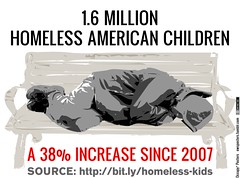The Mid-Winter holidays are coming soon. In a mere matter of weeks there will be celebrations of Christmas, Kwanzaa, Hanukkah, Yule, Festivus, and Solistice celebrations as well as many others. Almost all belief systems have a common thread: a celebration of light, goodwill and prosperity during the darkest part of the year.
While we sip cider and buttered rum, gather around the menora to light Hanukkah candles, or otherwise share the season with out fiends and relations, there are others who just want a place out of the bitter wind. Of those existing without a roof during this celebration of plenty, far too many of them are children.
While some children are nestled all snug in their beds, there are no visions of sugarplums dancing in the heads of their counterparts. Instead there is the shivering and fearful uncertainty of the child on the streets. (In case you have not noticed, it is cold out there!) To make matters worse, their numbers are increasing every day.
Pete Golis of the Press Democrat took notice of this in a recent column:
When I wrote last Christmas about homeless youngsters, there was hope that an improving economy might begin to reduce the number of young people at risk.
But workers on the front lines say the number of kids living on the street is getting bigger, not smaller. The most recent one-day survey counted 701 unaccompanied homeless youngsters in Sonoma County, plus 190 homeless families with children under 18.
The actual numbers are higher. There is simply no way for aid workers and volunteers to track all the young people being bounced from place to place, or all the young people who may be homeless at some time during the year.
At every agency that exists to help people in trouble, the story is the same: Hard times continue to grind away at job seekers and the people who rely on them for shelter and food.
How would you feel if one of your own children was sleeping under a bridge with cardboard for a blanket and one eye open out of fear? Consider it for a moment. No matter which seasonal holiday you adhere to, this is wrong and against the holiday spirit.
Lisa Fatu, a street outreach coordinator for Social Advocates for Youth, comments in the article about the effect of poverty on these populations. She points out that poverty also contributes to and exacerbates other causes of homelessness. Alcohol and drug addition, family violence and depression are frequent responses to deprivation. People “self medicate” or misdirect their anger a those around them when they feel boxed in. All these behaviors can combine with the current economy to put a family out of the streets.
I agree with Mr. Golis when he says:
At Christmastime or any time, it’s not acceptable that hundreds of kids are on the street. Children without a safe place to stay are more likely to be sick or injured, and more likely to be victims of a crime. They are more likely to fail in school, more likely to suffer depression and less likely to have friends.
The stabbing death last month of a 24-year-old homeless woman, Michela Anne Wooldridge, testifies to the risks young people face on the streets.
The realities of the street are harsh, especially for children. As we begin the yearly celebrations consider taking some time to help improve their lot. Mentoring and Big Brother programs are one way in which you can help. This is the time of life when kids develop the habits, skills, and reactions that will be with them for the rest of their lives. Embrace the generosity of the season and help give these young ones a chance at a better future.
Related articles
- 20 Facts About Hunger In America That Will Blow Your Mind (blacklistednews.com)
- Apartments.com Extends Invitation for America to “LIKE” Them to Help End Homelessness (virtual-strategy.com)
- Event brings awareness to hunger and homeless in the Chippewa Valley (weau.com)
- Jeff Bridges: A hunger to help kids (variety.com)












The “Homeless Count” that counties do across America do not try to capture every homeless person. They use a aystem which is necessarily highly flawed to come up with a preliminary, literal count and then extrapolate using a sense of the distribution of homeless people in their county in prior counts to come up with final totals. The official count is more likely to be an overcount than an undercount.
If it is a flawed methodology what do you suggest? I’d really like to hear some of your thoughts on ways to effectively combat the homeless issue, as well as what approach might generate more accurate info to work with. ( I know it can be unclear at times online so I’d like to stress that I am not being snarky. It is an honest questions.)